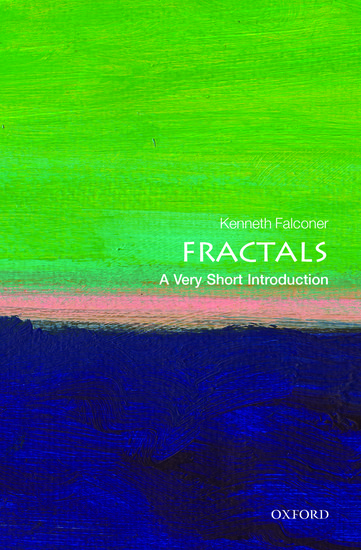Home >
A Very Short Introduction >
Fractals (Mathematics)
A Very Short Introduction | Mathematics
Fractals
ISBN: 9780199675982
Series: A Very Short Introduction
Fractals (Mathematics)
A Very Short Introduction Fractals (Mathematics) Media > Books > Non-Fiction > Education Books Expect Delays of Up to 4 Weeks| Order Below |
ISBN
9780199675982 (10-digit ISBN: 0199675988)
- Description
- Key Features
- Series Description
- Table of Contents
- An essential topic of study for mathematics students
- Looks at the historical roots of fractal theory
- Explains the basic concepts of fractal geometry with the minimum of mathematics
- Helps explain the concepts by illustrating a number of different fractals
- Examines a wide range of the applications across the sciences, and in aspects of economics
Many are familiar with the beauty and ubiquity of fractal forms within nature. Unlike the study of smooth forms such as spheres, fractal geometry describes more familiar shapes and patterns, such as the complex contours of coastlines, the outlines of clouds, and the branching of trees.
In this Very Short Introduction, Kenneth Falconer looks at the roots of the 'fractal revolution' that occurred in mathematics in the 20th century, presents the 'new geometry' of fractals, explains the basic concepts, and explores the wide range of applications in science, and in aspects of economics.
This is essential introductory reading for students of mathematics and science, and those interested in popular science and mathematics.
Reading Guide
From the contours of coastlines to the outlines of clouds, fractal shapes can be found regularly in nature. In this Very Short Introduction, Kenneth Falconer explains the basic concepts, presents the 'new geometry' of fractals, explores its wide range of applications, and shows the central place fractals have gained in mathematics and science in recent years.
Oxford's Very Short Introductions series offers concise and original introductions to a wide range of subjects--from Islam to Sociology, Politics to Classics, Literary Theory to History, and Archaeology to the Bible.
Not simply a textbook of definitions, each volume in this series provides trenchant and provocative--yet always balanced and complete--discussions of the central issues in a given discipline or field. Every Very Short Introduction gives a readable evolution of the subject in question, demonstrating how the subject has developed and how it has influenced society. Eventually, the series will encompass every major academic discipline, offering all students an accessible and abundant reference library.
Whatever the area of study that one deems important or appealing, whatever the topic that fascinates the general reader, the Very Short Introductions series has a handy and affordable guide that will likely prove indispensable.
Please note: As this series is not ELT material, these titles are not subject to discount.
Preface
1: The fractal concept
2: Self-similarity
3: Fractal dimension
4: Julia sets and the Mandelbrot set
5: Random walks and Brownian motion
6: Fractals in the real world
7: A little history
Further reading
Many are familiar with the beauty and ubiquity of fractal forms within nature. Unlike the study of smooth forms such as spheres, fractal geometry describes more familiar shapes and patterns, such as the complex contours of coastlines, the outlines of clouds, and the branching of trees.
In this Very Short Introduction, Kenneth Falconer looks at the roots of the 'fractal revolution' that occurred in mathematics in the 20th century, presents the 'new geometry' of fractals, explains the basic concepts, and explores the wide range of applications in science, and in aspects of economics.
This is essential introductory reading for students of mathematics and science, and those interested in popular science and mathematics.
Reading Guide
From the contours of coastlines to the outlines of clouds, fractal shapes can be found regularly in nature. In this Very Short Introduction, Kenneth Falconer explains the basic concepts, presents the 'new geometry' of fractals, explores its wide range of applications, and shows the central place fractals have gained in mathematics and science in recent years.
Key Features
- An essential topic of study for mathematics students
- Looks at the historical roots of fractal theory
- Explains the basic concepts of fractal geometry with the minimum of mathematics
- Helps explain the concepts by illustrating a number of different fractals
- Examines a wide range of the applications across the sciences, and in aspects of economics
Series Description
Oxford's Very Short Introductions series offers concise and original introductions to a wide range of subjects--from Islam to Sociology, Politics to Classics, Literary Theory to History, and Archaeology to the Bible.
Not simply a textbook of definitions, each volume in this series provides trenchant and provocative--yet always balanced and complete--discussions of the central issues in a given discipline or field. Every Very Short Introduction gives a readable evolution of the subject in question, demonstrating how the subject has developed and how it has influenced society. Eventually, the series will encompass every major academic discipline, offering all students an accessible and abundant reference library.
Whatever the area of study that one deems important or appealing, whatever the topic that fascinates the general reader, the Very Short Introductions series has a handy and affordable guide that will likely prove indispensable.
Please note: As this series is not ELT material, these titles are not subject to discount.
EASY ORDER FORM
PRICES LISTED INCLUDE CONSUMPTION TAX
Price Before Tax:
¥1,790


